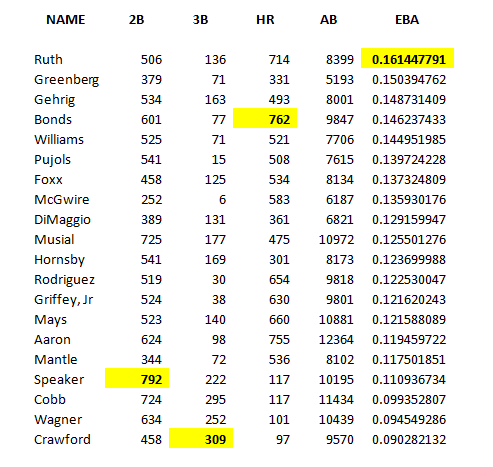By The Numbers: Taking A Closer Look At Extra-Base Average
By Father Gabe Costa
» More Columns
Nearly 20 years ago, several colleagues and I co-authored an article titled Percentage of Extra-Base Hits, which appeared in the Baseball Research Journal (Number 26, 1997). In the journal, which is a publication of the Society for American Baseball Research (SABR), we defined the percentage of extra-base hits (PXBH) as follows:

where 2B, 3B and HR are the number of doubles, triples and home runs, respectively, and H represents the total number of hits. We note that this number can be multiplied by 100 percent as a scaling factor.
Because of the advances in technology, perhaps not all readers will realize that "search engines" in 1997 were not what they are today. For our research back then, the "mining of the data" was accomplished through the heroic efforts of one of our colleagues, Mike Huber, who is now a dean at Muhlenberg College. He literally looked up everything by hand.
Our research showed that Hall of Famer Hank Greenberg had the highest career PXBH, as his career total of 781 extra-base hits divided by his total number of safeties (1628) gave him a lifetime PXBH of .4797. Babe Ruth was runner-up with a PXBH of .4720, with Phillies legend Mike Schmidt placing third at .4543.
Our rationale for defining our metric was to describe a way in which we would "not count the singles." We wondered if this would give us a new way to understand "power."
Over the years, there have been a number of interesting ways to look at hitting, especially from the perspective of power. For example, the instrument known as isolated power (ISO), is defined as follows:

where slugging percentage (SLG) and batting average (BA) are defined as usual, and at-bats are represented by AB. In a sense, ISO can be thought of as the "power beyond first base." The only sluggers in history with an ISO greater than .300 are Babe Ruth (.348), Mark McGwire (.325) and Barry Bonds (.309).
Another approach is that of secondary average (SECA). SECA takes walks (BB), stolen bases (SB) and times caught stealing (CS) into account. It is defined below:

Bonds is the only player in history with a SECA of over .600, with a career mark of .606. He is followed by Ruth (.594) and Ted Williams (.553).
In this installment of By The Numbers, I would like to examine another metric, that of extra base average (EBA). The EBA is defined as:

which simply removes all singles from the discussion. It gives the "average" number of extra-base hits per at-bat. In the following table I've listed 20 great hitters (mostly Hall of Famers) with their corresponding 2B, 3B HR and EBA totals. I've included both Tris Speaker and Sam Crawford, as they are the career leaders in doubles and triples, respectively. Regarding Albert Pujols, the only active player on the list, his numbers include approximately the first half of the 2014 season.

It is not surprising that Ruth tops the EBA list. Yet Greenberg -- who toppoed our PXBH chart in 1997 -- is right behind Ruth. "Hammerin' Hank" seems to be one of those "forgotten players" of the past.
Greenberg was one of the most powerful sluggers in history. In the 1930s, he, Jimmie Foxx and Lou Gehrig formed a triumvirate of slugging first basemen that no decade, before or since, has ever seen. In 1937, Greenberg drove in 183 runs, two less than the American League record set by Gehrig in 1931. The following year he hit 58 home runs, falling two short of the then-record of 60 set by Ruth.
Greenberg was one of the first major leaguers to serve in World War II, spending nearly four years with the United States Army Air Forces. Had his career been uninterrupted, he certainly would have smashed 500 home runs, and his lifetime totals would rank right up there with his main rivals, Double X and The Iron Horse.
After playing with the Detroit Tigers for his entire career, Greenberg spent his last season (1947) with the Pittsburgh Pirates. While there, he mentored a young outfielder who could also hit home runs: Ralph Kiner.
Greenberg was enshrined into the Hall of Fame in 1956. 30 years later he died. By all accounts he was a wonderful individual. He deserves to be remembered.
You May Also Be Interested In These Stories



